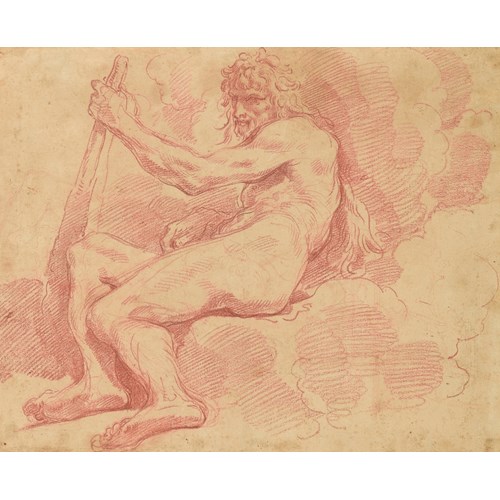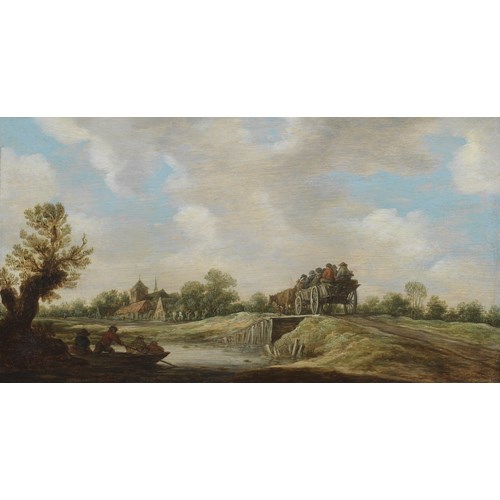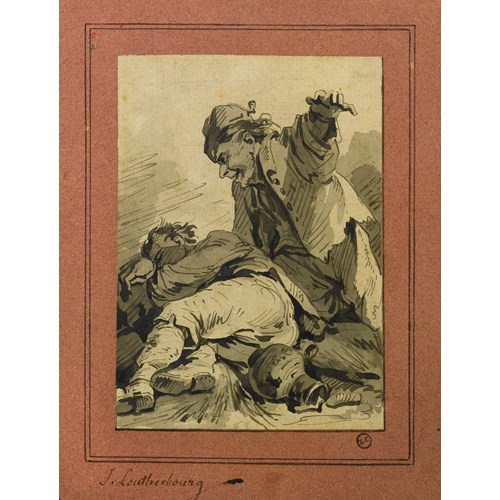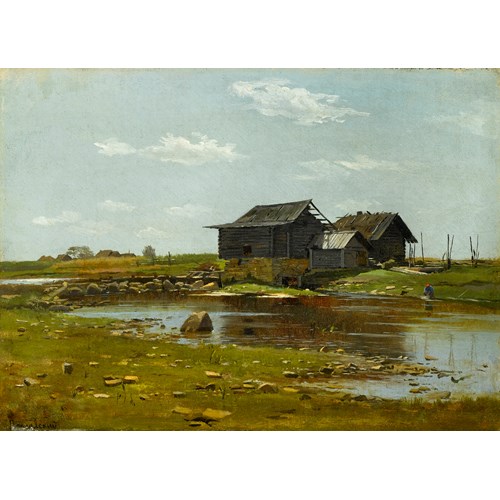Marketplace
A Card Game in a Courtyard
Maerten Stoop
A Card Game in a Courtyard
Period 1600-1750, 17th century
Origin The Netherlands
Medium Oil on panel
Dimension 46 x 62.6 cm (18¹/₈ x 24⁵/₈ inches)
This finely detailed and engaging painting is a rare work by Maerten Stoop, an artist whose surviving works are sadly limited by the brevity of his career. Stoop specialised in genre painting and in particular guardroom subjects, portraying off-duty officers in scenes of relaxation and merriment, of which A Card Game in a Courtyard is an exceptionally fine example.
Guardroom subjects were initially popularised in German prints of the sixteenth century and in the large-scale figure scenes of Utrecht painters in the beginning of the seventeenth century.¹ In 1621, the Twelve Year Truce ended and fighting between the Dutch and Spanish resumed until the Treaty of Münster in 1648, when the Dutch gained their independence. The eighty year struggle made soldiers, mercenaries and members of the civic guard, male citizens who paid dues and had the right to carry firearms, rcognisable figures in Dutch seventeenth-century life and consequently the subject of paintings by Stoop and a number of his contemporaries. The buyers of guardroom paintings would have been predominantly from prosperous northern cities, which had not been directly affected by the warfare gripping the rest of the Netherlands, but would nevertheless have been interested in depictions of military life.
A Card Game in a Courtyard presents a scene in which a conspicuously well dressed woman plays a game of cards with two soldiers in a courtyard. The figures are bathed in an intensely bright light, in contrast to their surroundings, which reflects off the woman’s white dress and pale skin. The company are assembled in a makeshift fashion, seated around a drum instead of a card table, and strewn about them, amongst the dirt and hay of the ground, are garments and pieces of armour that have been casually cast aside. They sit on a platform raised above the rest of the courtyard floor, on the edge of which a small dog stands alert. He faces towards a large archway on the left, through which a soldier in a brown cloak, plumed hat, blue breeches and floppy boots pensively strolls. His face is downcast in shadow and he is seemingly oblivious to the rollicking entertainment being had by the card players. Behind him, two other soldiers, clad in blue and brown, are shown relaxing and whiling away the afternoon.
The three card players in the centre of the scene are shown reacting to the arrival of a gentleman who enters the courtyard from a side door. One of the seated soldiers flamboyantly doffs his hat while the other one peeks at the lady’s cards, as she exposes in a moment of distraction. Not only the presence of the female, but also her inviting gaze, casual pose and revealing body language, with one arm outstretched, dangling a locket on a chain as if to lure the visitor into the game, suggests that she is likely to be of dubious virtue. It would appear that her jewellery is being used as the stakes for the game, and the locket will soon join the pearl necklace that has already been surrendered and lies on the drum. Luxuriously clad in a white silk dress, embroidered with gold and tied at the waist with a peach coloured sash, the lady appears not to mind risking her valuables. The man seated across from her is dressed in a dishevelled, cavalier manner, with his bare knee showing from between his breeches and hose and his coat carelessly flung behind him. He wears a buff doublet with slashed sleeves, and a shirt with a large soft collar. His relaxed and informal appearance suggests he has been off duty for a length of time, in contrast to his comrade who is entering from outside, dressed in a voluminous blue cloak with boots pulled up well above the knee for warmth.
The low vantage point from which Stoop depicts A Card Game in a Courtyard shortens and exaggerates the already rotund bodies of his subjects. Their plump faces are portrayed tilted either up or down, emphasising the folds under their chins and the roundness of their cheeks, giving them a jovial and naturalistic appearance. These techniques are used repeatedly by Stoop to portray soldiers and their companions thus lending them an unpretentious charm and approachability. In another painting by Stoop, An Interior Scene with an Officer and a Seated Woman Smoking a Pipe, (private collection) the figures are grouped in a corner of a room by the fireplace. A large part of the composition, as in the present painting, is taken up detailing the spartan interior with its plain brown walls. The depiction of the ceiling’s rafters stretching across the room suggests that the artist is painting the scene from a seated position on the floor much like the figures in the present painting. In Stoop’s pictures, there is a noticeable lack of furniture and the figures are resourceful with the objects around them.
In An Interior Scene with an Officer and a Seated Woman Smoking a Pipe, the swaggering officer figures most prominently, wearing a pink doublet and breeches and matching cloak, with a buff jerkin jauntily tied at his waist with a sash. He stands with one arm on his hip and the other raised behind his head. He has a pleasantly jovial demeanour and appears to joke with the woman seated near him. She stares vacantly out of the window while holding a pipe. Similarly, in the present picture, the subjects are shown passing the time and whether in their quarters or camped in a courtyard, they are trying to divert themselves while off duty.
A combination of cheerfully rotund figures and meticulous attention to detail defines Stoop’s work. In A Card Game in a Courtyard, his depiction of even the smallest item is exact and the play of light on each one gives it added dimension, from the locket held out in the woman’s hand to the locks on the open trunk at her side. Stoop’s ability to render the textures of different surfaces makes the objects appear tangible. The sartorial detail is equally impressive, with each fold of the lady’s dress and each button and loop of the soldier’s coat convincingly painted so as to immediately engage the viewer’s eye.
Stoop’s powers of observation are matched by his sense of humour, which is evident in his painting An Officer in Billeted Quarters, in the Rijksmuseum . The officer, revealed in a state of undress, smoking a pipe, is nonchalant and self-absorbed. He absent-mindedly lifts one of his legs so that a boy can remove his boot and in the meantime fails to notice the woman in the corner of the room rifling through his belongings. She glances cursorily towards him while leaning over the open trunk but the officer is turned away, seemingly lost in contemplation of the curls of smoke swirling from his pipe. His surroundings are in a state of neglect, with the rough wooden beams of the ceiling and the brickwork of the walls exposed, and his clothing and personal belongings flung carelessly about. The disarray and chaos of the soldier’s quarters, like that of the courtyard in the present painting, clearly delighted Stoop and he portrayed his subjects’ surroundings as vividly as he did their dress and character. Interior views also gave Stoop an opportunity to demonstrate his handling of perspective, which was clearly of particular importance in A Card Game in a Courtyard, as the doorways to the right and left of the central group and the vista through to a secondary room give the composition a greater depth and enhance the illusion of space.
Stoop was a contemporary of Nicolaes Knupfer (c.1609-1655), a German painter who depicted genre and narrative scenes set in Utrecht, and Jacob Duck (c.1600-1667) who, like Stoop, specialised in guardroom pictures. Duck’s painting, Interior with Soldiers and Women, exemplifies the subject matter that characterised his work. Like Stoop, Duck employed a relatively monotone palette, heightened only by the addition of a brightly coloured sash or garment, in this case the vivid pink of one on the soldier’s hose, casually unrolled. The soldiers wear buff jerkins or doublets from which their white shirt sleeves show, and plumed hats. They present themselves in a confidently casual manner similar to that of the men in A Card Game in a Courtyard or An Interior Scene with an Officer and a Seated Woman Smoking a Pipe. Discarded guns and pieces of armour are scattered around the room, as well as a bass viol, which is propped up against the wall. The inclusion of a musical instrument as a motif in painting, could be interpreted as a commentary on the harmonies of sexual attraction. The teasing tension and flirtatiousness between the sexes is evident, as in A Card Game in a Courtyard.
Stoop was the son of the stained-glass artist Willem Jansz. Stoop (fl. 1633-44) and the brother of Dirck Stoop (1610-1686), who specialised in Italianate landscapes with hunting parties, views of ports, cavalry scenes and history paintings. It is thought that Maerten was an apprentice in the Utrecht Guild of St. Luke in 1638, which explains the similarities between his oeuvre and that of Knupfer and Duck. Biographical details about the artist, however, are even more scarce than examples of his work.
¹ Wayne Franits, Dutch Seventeenth-Century Genre Painting, New Haven and London 2004, pp.60-63.
Guardroom subjects were initially popularised in German prints of the sixteenth century and in the large-scale figure scenes of Utrecht painters in the beginning of the seventeenth century.¹ In 1621, the Twelve Year Truce ended and fighting between the Dutch and Spanish resumed until the Treaty of Münster in 1648, when the Dutch gained their independence. The eighty year struggle made soldiers, mercenaries and members of the civic guard, male citizens who paid dues and had the right to carry firearms, rcognisable figures in Dutch seventeenth-century life and consequently the subject of paintings by Stoop and a number of his contemporaries. The buyers of guardroom paintings would have been predominantly from prosperous northern cities, which had not been directly affected by the warfare gripping the rest of the Netherlands, but would nevertheless have been interested in depictions of military life.
A Card Game in a Courtyard presents a scene in which a conspicuously well dressed woman plays a game of cards with two soldiers in a courtyard. The figures are bathed in an intensely bright light, in contrast to their surroundings, which reflects off the woman’s white dress and pale skin. The company are assembled in a makeshift fashion, seated around a drum instead of a card table, and strewn about them, amongst the dirt and hay of the ground, are garments and pieces of armour that have been casually cast aside. They sit on a platform raised above the rest of the courtyard floor, on the edge of which a small dog stands alert. He faces towards a large archway on the left, through which a soldier in a brown cloak, plumed hat, blue breeches and floppy boots pensively strolls. His face is downcast in shadow and he is seemingly oblivious to the rollicking entertainment being had by the card players. Behind him, two other soldiers, clad in blue and brown, are shown relaxing and whiling away the afternoon.
The three card players in the centre of the scene are shown reacting to the arrival of a gentleman who enters the courtyard from a side door. One of the seated soldiers flamboyantly doffs his hat while the other one peeks at the lady’s cards, as she exposes in a moment of distraction. Not only the presence of the female, but also her inviting gaze, casual pose and revealing body language, with one arm outstretched, dangling a locket on a chain as if to lure the visitor into the game, suggests that she is likely to be of dubious virtue. It would appear that her jewellery is being used as the stakes for the game, and the locket will soon join the pearl necklace that has already been surrendered and lies on the drum. Luxuriously clad in a white silk dress, embroidered with gold and tied at the waist with a peach coloured sash, the lady appears not to mind risking her valuables. The man seated across from her is dressed in a dishevelled, cavalier manner, with his bare knee showing from between his breeches and hose and his coat carelessly flung behind him. He wears a buff doublet with slashed sleeves, and a shirt with a large soft collar. His relaxed and informal appearance suggests he has been off duty for a length of time, in contrast to his comrade who is entering from outside, dressed in a voluminous blue cloak with boots pulled up well above the knee for warmth.
The low vantage point from which Stoop depicts A Card Game in a Courtyard shortens and exaggerates the already rotund bodies of his subjects. Their plump faces are portrayed tilted either up or down, emphasising the folds under their chins and the roundness of their cheeks, giving them a jovial and naturalistic appearance. These techniques are used repeatedly by Stoop to portray soldiers and their companions thus lending them an unpretentious charm and approachability. In another painting by Stoop, An Interior Scene with an Officer and a Seated Woman Smoking a Pipe, (private collection) the figures are grouped in a corner of a room by the fireplace. A large part of the composition, as in the present painting, is taken up detailing the spartan interior with its plain brown walls. The depiction of the ceiling’s rafters stretching across the room suggests that the artist is painting the scene from a seated position on the floor much like the figures in the present painting. In Stoop’s pictures, there is a noticeable lack of furniture and the figures are resourceful with the objects around them.
In An Interior Scene with an Officer and a Seated Woman Smoking a Pipe, the swaggering officer figures most prominently, wearing a pink doublet and breeches and matching cloak, with a buff jerkin jauntily tied at his waist with a sash. He stands with one arm on his hip and the other raised behind his head. He has a pleasantly jovial demeanour and appears to joke with the woman seated near him. She stares vacantly out of the window while holding a pipe. Similarly, in the present picture, the subjects are shown passing the time and whether in their quarters or camped in a courtyard, they are trying to divert themselves while off duty.
A combination of cheerfully rotund figures and meticulous attention to detail defines Stoop’s work. In A Card Game in a Courtyard, his depiction of even the smallest item is exact and the play of light on each one gives it added dimension, from the locket held out in the woman’s hand to the locks on the open trunk at her side. Stoop’s ability to render the textures of different surfaces makes the objects appear tangible. The sartorial detail is equally impressive, with each fold of the lady’s dress and each button and loop of the soldier’s coat convincingly painted so as to immediately engage the viewer’s eye.
Stoop’s powers of observation are matched by his sense of humour, which is evident in his painting An Officer in Billeted Quarters, in the Rijksmuseum . The officer, revealed in a state of undress, smoking a pipe, is nonchalant and self-absorbed. He absent-mindedly lifts one of his legs so that a boy can remove his boot and in the meantime fails to notice the woman in the corner of the room rifling through his belongings. She glances cursorily towards him while leaning over the open trunk but the officer is turned away, seemingly lost in contemplation of the curls of smoke swirling from his pipe. His surroundings are in a state of neglect, with the rough wooden beams of the ceiling and the brickwork of the walls exposed, and his clothing and personal belongings flung carelessly about. The disarray and chaos of the soldier’s quarters, like that of the courtyard in the present painting, clearly delighted Stoop and he portrayed his subjects’ surroundings as vividly as he did their dress and character. Interior views also gave Stoop an opportunity to demonstrate his handling of perspective, which was clearly of particular importance in A Card Game in a Courtyard, as the doorways to the right and left of the central group and the vista through to a secondary room give the composition a greater depth and enhance the illusion of space.
Stoop was a contemporary of Nicolaes Knupfer (c.1609-1655), a German painter who depicted genre and narrative scenes set in Utrecht, and Jacob Duck (c.1600-1667) who, like Stoop, specialised in guardroom pictures. Duck’s painting, Interior with Soldiers and Women, exemplifies the subject matter that characterised his work. Like Stoop, Duck employed a relatively monotone palette, heightened only by the addition of a brightly coloured sash or garment, in this case the vivid pink of one on the soldier’s hose, casually unrolled. The soldiers wear buff jerkins or doublets from which their white shirt sleeves show, and plumed hats. They present themselves in a confidently casual manner similar to that of the men in A Card Game in a Courtyard or An Interior Scene with an Officer and a Seated Woman Smoking a Pipe. Discarded guns and pieces of armour are scattered around the room, as well as a bass viol, which is propped up against the wall. The inclusion of a musical instrument as a motif in painting, could be interpreted as a commentary on the harmonies of sexual attraction. The teasing tension and flirtatiousness between the sexes is evident, as in A Card Game in a Courtyard.
Stoop was the son of the stained-glass artist Willem Jansz. Stoop (fl. 1633-44) and the brother of Dirck Stoop (1610-1686), who specialised in Italianate landscapes with hunting parties, views of ports, cavalry scenes and history paintings. It is thought that Maerten was an apprentice in the Utrecht Guild of St. Luke in 1638, which explains the similarities between his oeuvre and that of Knupfer and Duck. Biographical details about the artist, however, are even more scarce than examples of his work.
¹ Wayne Franits, Dutch Seventeenth-Century Genre Painting, New Haven and London 2004, pp.60-63.
Period: 1600-1750, 17th century
Origin: The Netherlands
Medium: Oil on panel
Signature: Signed ‘MStoop’ (lower left), stamped on the reverse with the panel maker’s mark ‘SvM’ (in monogram).
Dimension: 46 x 62.6 cm (18¹/₈ x 24⁵/₈ inches)
Provenance: M. & G. Segal, Basel, 1980.
More artworks from the Gallery









